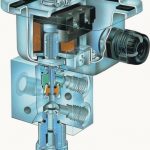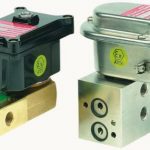End users in the chemical industry tend to focus on their core competence and therefore have a broader procurement perspective. They purchase not only engineering work and actual equipment but also maintenance and even operating services. In some cases, this approach also extends to shared plant performance risks. Devices such as solenoid valves must be tested accordingly in order to ensure the necessary functional safety.
Willem van der Bijl
The safety aspect is a crucial factor in the chemical industry. The problem with safety is that it can be interpreted in so many different ways. How is safety defined? What are the risks? What are the consequences of an emergency situation? These consequences naturally have a serious impact not only on the potential danger to employees but also on profits, the environment and the company’s image.
Functional safety is part of the overall safety that depends on a system or equipment operating correctly in response to its inputs. This can never be guaranteed one hundred percent. Although it is possible to aim for maximum safety, this results in extremely high costs and an inoperable plant. For this reason, it is important to strive for the right balance between operability, safety and costs.
Standards
Several standards have been developed to enable this goal to be achieved efficiently. Originally, two German DIN standards dealt with functional safety aspects of measurement and control systems (DIN 19250 in 1994) and related safeguarding functions (DIN 19251 in 1995). In the meantime, IEC 61508 and IEC 61511 – which specify SIL (Safety Integrity Level) classes – are emerging as the established benchmark for classifying safety systems. They are readily accessible and provide a relatively simple way of determining the functional safety level of a process installation. The publication of the underlying IEC 61508 standard and the development of IEC 61511 already mean that field instruments are the weakest link (apart from human operators) in the safety chain.
IEC 61511 is primarily concerned with safety instrumented systems for the process sector. It also requires the performance of a process hazard and risk assessment, in order to derive the risk reduction targets to be achieved by the safety instrumented systems.
Risk reduction targets are defined using four levels:
- Level 1 = minor property and production protection
- Level 2 = major property and production protection (possible employee injury)
- Level 3 = employee and community protection
- Level 4 = catastrophic community impact
In addition to assigning safety integrity levels to safety instrumented functions, IEC 61511 introduces the concept of life cycle safety management. Life cycle safety management is intended to ensure that the targeted risk reductions are achieved in all life cycle phases of the plant, from conception to demolition.
Pilot valves in safety systems
Safety systems basically consist of three elements; the sensor, the logic solver and the final element. The sensor measures the process and acts as the input to the logic solver. If the output of the sensor exceeds a certain value, the logic solver trips and sends a signal to the final element. The final element shuts off the process and safety is maintained.
Solenoid valves are an essential part of the safety loop. They directly control the actuator of on/off valves. In normal operation the solenoid is energised and open, activating the actuator. Control valves control the process flow in normal operation by varying the actuator pressure, so that the valve moves to the correct position. If a failure occurs, for example if the level in a vessel exceeds the high limit, the valve must change to its safe position.
Safety in these systems depends to a large extent on the reliability of the pilot valve. This means that the solenoid valves not only need to be manufactured to a high quality standard, they also have to be extensively tested. Five basic steps are undertaken to achieve this:
- Functional description of the valve design and test sample
- Quality test of valve functions according to EN 161/DIN 3394
- Functional analysis providing an AK classification according to DIN 19251
- Quantitative valve testing providing a PFD value for IEC 61508
- Manufacturing quality audit
Step one is an internally documented test (product file) to ensure that the product is appropriate. Step two concerns a type test for automatic shut-off valves that is performed in Germany by the TÜV. Step three relates to the functional analysis that is carried out by the TÜV in accordance with the DIN 19251 standard. For every AK class from 1 to 8, this standard specifies a package of technical and non-technical system requirements intended to prevent failures or mitigate the effects of such failures. Step four has a bearing on the actual quantitative testing of the equipment. This test is also performed by the TÜV and provides a PFD value for the solenoid valve. A number of randomly selected valves are electrically operated under various conditions. The final step concerns special supplements to the standard ISO 9000 procedures dealing with material flow, audits, testing and fail-ure statistics.
The 327 and 551 pilot valve models from Asco Joucomatic have successfully completed all of the above tests. These models are therefore suitable for use in safety applications up to AK 7 and are equally appropriate for safety applications up to SIL 4 with PFD <4×10-7. It is important to note that the full AK 7 approval can only be obtained if each user also fulfils their own list of related requirements. The approval is valid for all current specifications. It allows use in all environments and with an extensive range of solenoid and valve combinations.
The pilot valves for hazardous area applications, for example, are designed in such a way that the ignition source is isolated. The maximum IIC T6 classification is achieved, permitting the use of these pilot valves in all types of explosive mixture above ground up to zone 0 or category 1.
cpp 402
Special services
Many companies that offer traditional equipment, enhance their services. In view of the safety aspects, a crucial condition is that the people involved in these services have thorough understanding of functional safety and application in hazardous areas. Asco Joucomatic over the past years has changed its market approach by including the safety awareness. For this reason Asco has invested in additional services, such as education, maintenance and application support.
Share:








